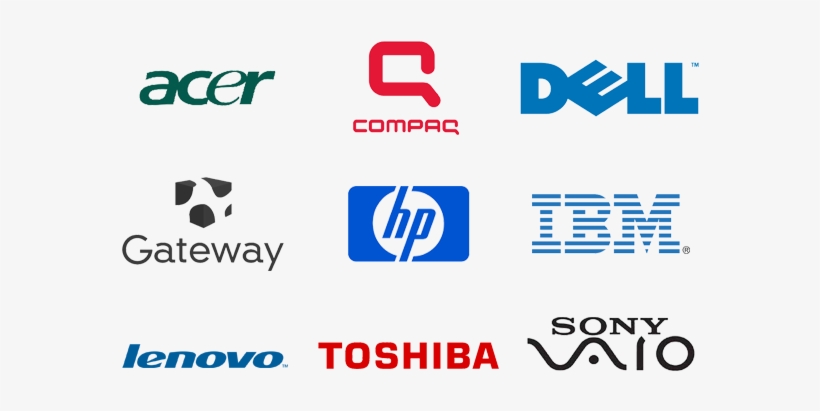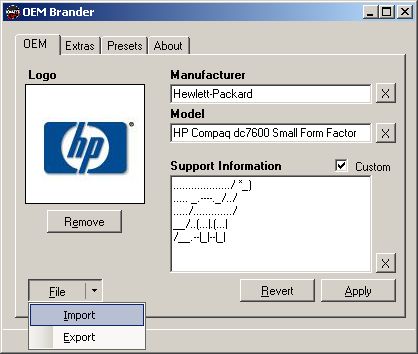
An original equipment manufacturer (OEM) is a company that produces parts and equipment that may be marketed by another manufacturer. The largest OEM company in the world by both scale and revenue is Foxconn, a Taiwanese electronics company, which manufactures parts and equipment for companies including Apple, Dell, Google, Huawei and Nintendo.
File Details | |
| File Size | 1.4 MB |
|---|---|
| License | Freeware |
| Operating System | Windows (All) |
| Date Added | December 15, 2013 |
| Total Downloads | 7,406 |
| Publisher | StormPooperSmith |
| Homepage | OEM Brander |
Publisher's Description
OEM Brander is free portable application designed to allow you to edit OEM branding on a Windows PC. When you buy a PC from a manufacturer, they will usually have the Make, Model and Support information in the Systems Property window, as well as a company logo. OEM Brander enables you to edit this information and to use your own logo, which will be automatically resized and scaled to fit. Unlike other OEM branding applications, OEM Brander supports Windows XP and Windows Vista/7, preset manufacturer information and the ability to edit Vista/7-specific images.
mindyourmanners reviewed v1.7.0.0 on May 23, 2012
I have been using winbubble for W7 and Vista and manually doing XP branding. Thought I would try this as it claims to do all three operating systems. Just tried it on a Windows 7 and a Vista machine and it worked perfectly with the added bonus that it does not have all the other garbage that winbubble comes with.
Its simple, straightforward and clutter free. They can definately claim me as a convert.
To the Author(s), many thanks.
mindyourmanners reviewed v1.7.0.0 on May 23, 2012
I have been using winbubble for W7 and Vista and manually doing XP branding. Thought I would try this as it claims to do all three operating systems. Just tried it on a Windows 7 and a Vista machine and it worked perfectly with the added bonus that it does not have all the other garbage that winbubble comes with.
Its simple, straightforward and clutter free. They can definately claim me as a convert.
To the Author(s), many thanks.
An original equipment manufacturer (OEM) is a company that purchases parts and equipment that may be manufactured by another company. For example, Foxconn, a Taiwanese electronics company, which manufactures parts and equipment for OEMs including Apple, Dell, Google, Huawei and Nintendo.
Xhorse firmware update tool download. The term is also used in several other ways, which causes ambiguity. It sometimes means the maker of a system that includes other companies' subsystems, an end-product producer, an automotive part that is manufactured by the same company that produced the original part used in the automobile's assembly, or a value-added reseller.[1][2][3]

Automotive parts[edit]
When referring to auto parts, OEM refers to the manufacturer of the original equipment, that is, the parts assembled and installed during the construction of a new vehicle. In contrast, aftermarket parts are those made by companies other than the OEM, which might be installed as replacements after the car comes out of the factory. For example, if Ford used Autolitespark plugs, Exide batteries, Boschfuel injectors, and Ford's own engine blocks and heads when building a car, then car restorers and collectors consider those to be the OEM parts.[citation needed] Other-brand parts would be considered aftermarket, such as Champion spark plugs, DieHard batteries, Kinsler fuel injectors, and BMP engine blocks and heads. Many auto parts manufacturers sell parts through multiple channels, for example to car makers for installation during new-vehicle construction, to car makers for resale as automaker-branded replacement parts, and through general merchandising supply chains. Any given brand of part can be OEM on some vehicle models and aftermarket on others.
Computer software[edit]
Microsoft is a popular example of a company that issues its Windows operating systems for use by OEM computer manufacturers via the Bundling of Microsoft Windows. OEM product keys are priced lower than their retail counterparts, especially as they are purchased in bulk quantities. But they use the same software as retail versions of Windows. They are primarily for PC manufacturer OEMs and system builders, and as such are typically sold in volume licensing deals to a variety of manufacturers (Dell, HP, ASUS, Acer, Lenovo, Wistron, Inventec, Supermicro, Compal Electronics, Quanta Computer, Foxconn, Pegatron, Jabil, Flex, etc.). These OEMs commonly use a procedure known as System Locked Pre-installation, which pre-activates Windows on PCs that are to be sold via mass distribution. These OEMs commonly bundle software that is otherwise not pre-installed on Windows from Microsoft themselves, on the images of Windows that will be deployed with their PCs (appropriate hardware drivers, malware and maintenance software, various apps, etc).
Individuals may also purchase OEM 'system-builder' licenses for personal use (to include virtual hardware), or for sale/resale on PCs which they build. Per Microsoft’s EULA regarding PC manufacturers and system-builder OEM licenses, the product key is tied to the PC motherboard which it’s initially installed on, and there is typically no transferring the key between PCs afterward. This is in contrast to retail keys, which may be transferred, provided they are only activated on one PC at a time. A significant hardware change will trigger a reactivation notice, just as with retail.[4]
Direct OEMs are officially held liable for things such as installation/recovery media, and as such were commonly provided until the late-2000s. These were then phased out in favor of recovery partitions located on the primary storage drive of the PC (and available for order from the manufacturer upon request) for the user to repair or restore their systems to the factory state. This not only cut down on costs, but was also a consequence of the gradual obsolescence and phasing out of optical media from 2010 onward. System builders further have a different requirement regarding installation media from Direct OEMs.[5][6]
While clean retail media of Windows can be installed and activated on these devices with OEM keys (most commonly using the SLP key that's embedded in to the system firmware already), actual OEM recovery media that was created by the PC manufacturer (not system-builder, nor retail Windows versions) typically only works on the PC model line that was designed for it. So a recovery disc/USB for a Toshiba Satellite P50-B will only work on that model, and not a Satellite S55T.
Economies of scale[edit]
OEMs rely on their ability to drive down the cost of production through economies of scale. Also, using an OEM allows the purchasing company to obtain needed components or products without owning and operating a factory.
See also[edit]
- Electronics manufacturing services (EMS)
- Original design manufacturer (ODM)
- Value-added reseller (VAR)
References[edit]
- ^'Build Your Brand on HP: HP OEM Partnership'(PDF). Hewlett-Packard Website. Hewlett-Packard. Retrieved 2014-09-27.
- ^Ken Olsen: PDP-1 and PDP-8 (page 3), economicadventure.com
- ^Kidder, Tracy (1997). 'Book Excerpt: The Soul of a New Machine'. Bloomberg Business Week. Retrieved 2014-09-27.
…hence the rise of companies known as original equipment manufacturers, or OEMs—they'd buy gear from various companies and put it together in packages. (Chapter One, paragraph 17)
- ^'General Info on Microsoft OEM COA's, CDs, Ect'. eBay. Retrieved 9 September 2015.
- ^'OEM Licensing FAQ-OEM Partner Center'. Microsoft.com. Microsoft Corporation. Retrieved 1 October 2015.
- ^'OEM System Builder Licensing Guide'(PDF). Microsoft.com. Microsoft Corporation. Retrieved 9 September 2015.